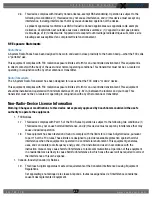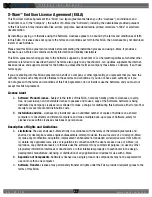
O P E R A T I N G M A N U A L
8 0 0 . 7 4 9 . 2 7 6 1
w w w . c o a c h c o m m . c o m
8 8
Glossary
AudioCom
®
XLR Terminations
Balanced Audio -
A form of transmitting a wired
signal. Balanced systems use two wires for each
talk line. The audio is out of phase 180 degrees
from one wire to the other. In this way, noise can be
filtered out more easily. Balanced audio is usually
much less susceptible to hum and interference
from long cable runs.
Conference -
A grouping of audio entities. Wireless
Radio Packs may subscribe to one or more conferences.
Dry Pair -
A twisted pair of wires, typically connecting between the press box and the sidelines. For the Telex
®
AudioCom
®
system operating from power on one end only, this wire should be 26 gauge or better.
Mic Gain -
Increase in the power of the signal from the microphone
Mic Type -
Either electret or dynamic, determined by user selection or system auto-detection
Noise Gate -
Dynamic processor that suppresses unwanted noise present when the audio signal is at a low level
Profile -
A Radio Pack Profile assigns functionality to a Radio Pack’s local controls, knobs, and buttons as well as what
conferences they subscribe to.
RJ-14
- A telephone jack used to make connections
with dry pair. By definition, the RJ-14 has two pair
(i.e., four wires). It is often confused with an RJ-11
(two wires). Some phone technicians will call these
RJ-11 4 wire jacks. Please note the unique wiring of
the RJ-14 for the X-System application in Figure 114.
Sidetone -
The user’s own voice folded back into the
user’s ear. This adjustment allows for a user to hear
more or less of his/her own voice in his/her headset.
If sidetone is turned down, the user can still hear
other users but he/she cannot hear his/her own voice. If the sidetone is turned up too far, the user may cause “feedback” or
squealing on his/her intercom line.
Figure 113: XLR Terminations
Figure 114: RJ-14 Wiring






























